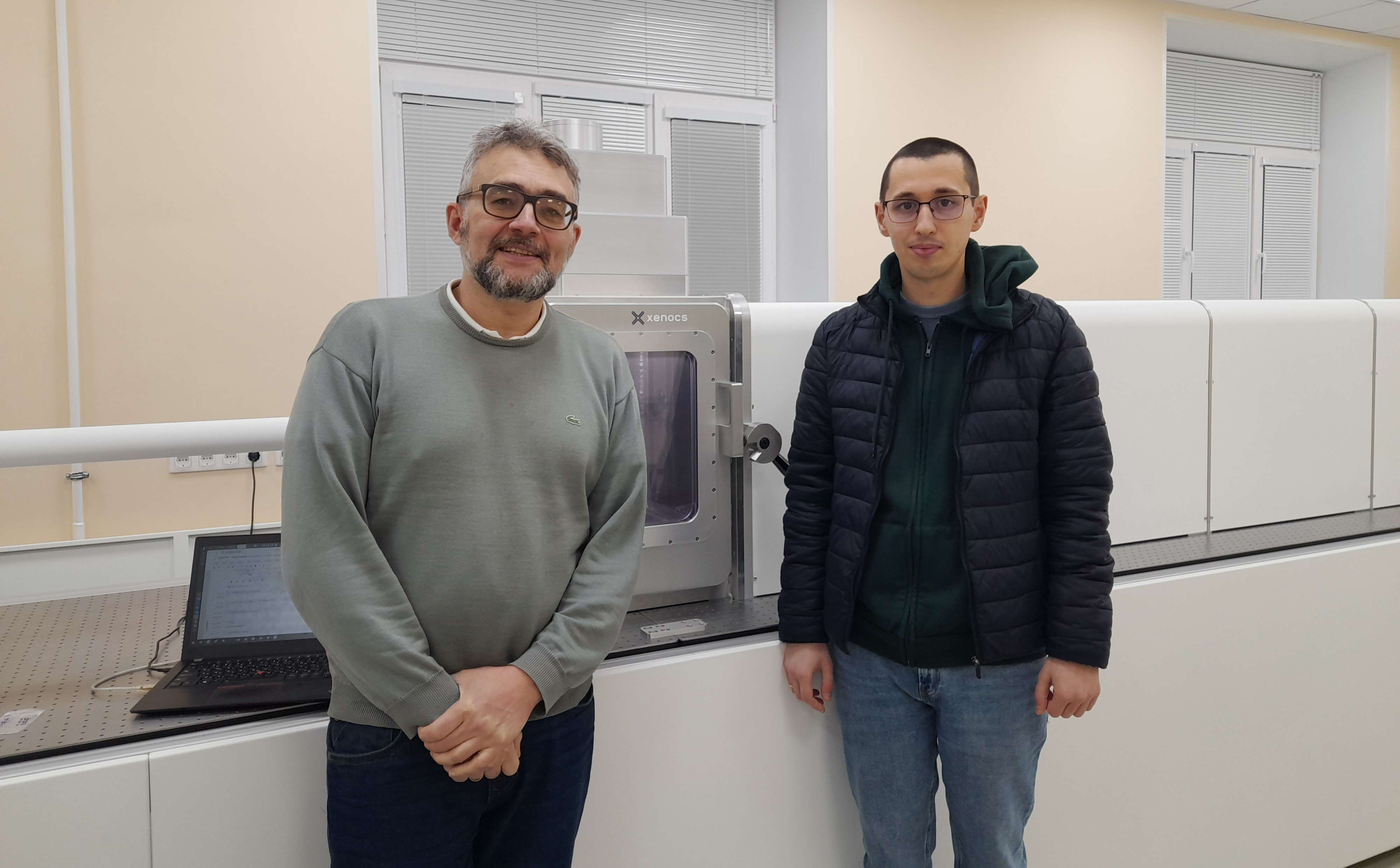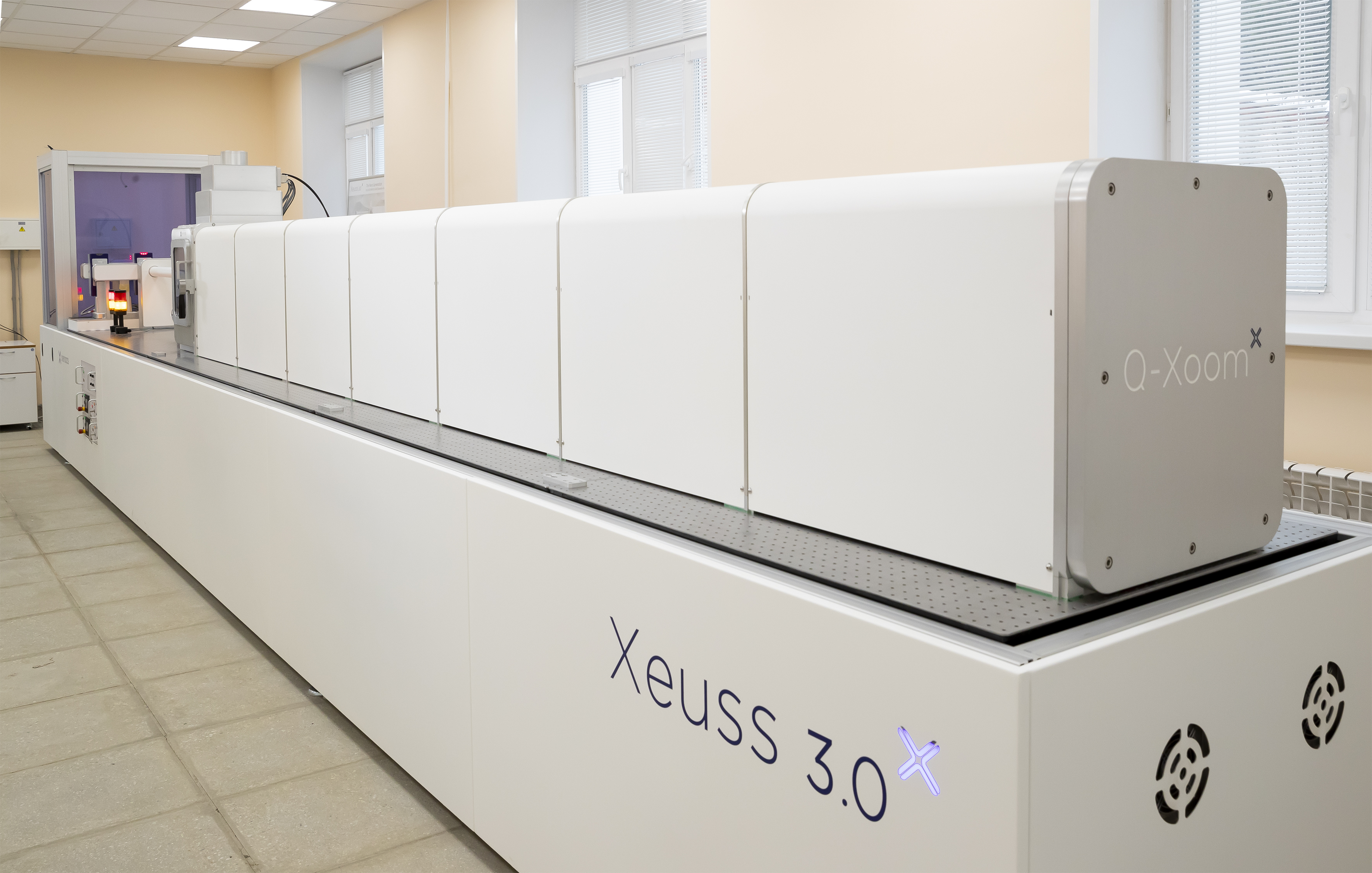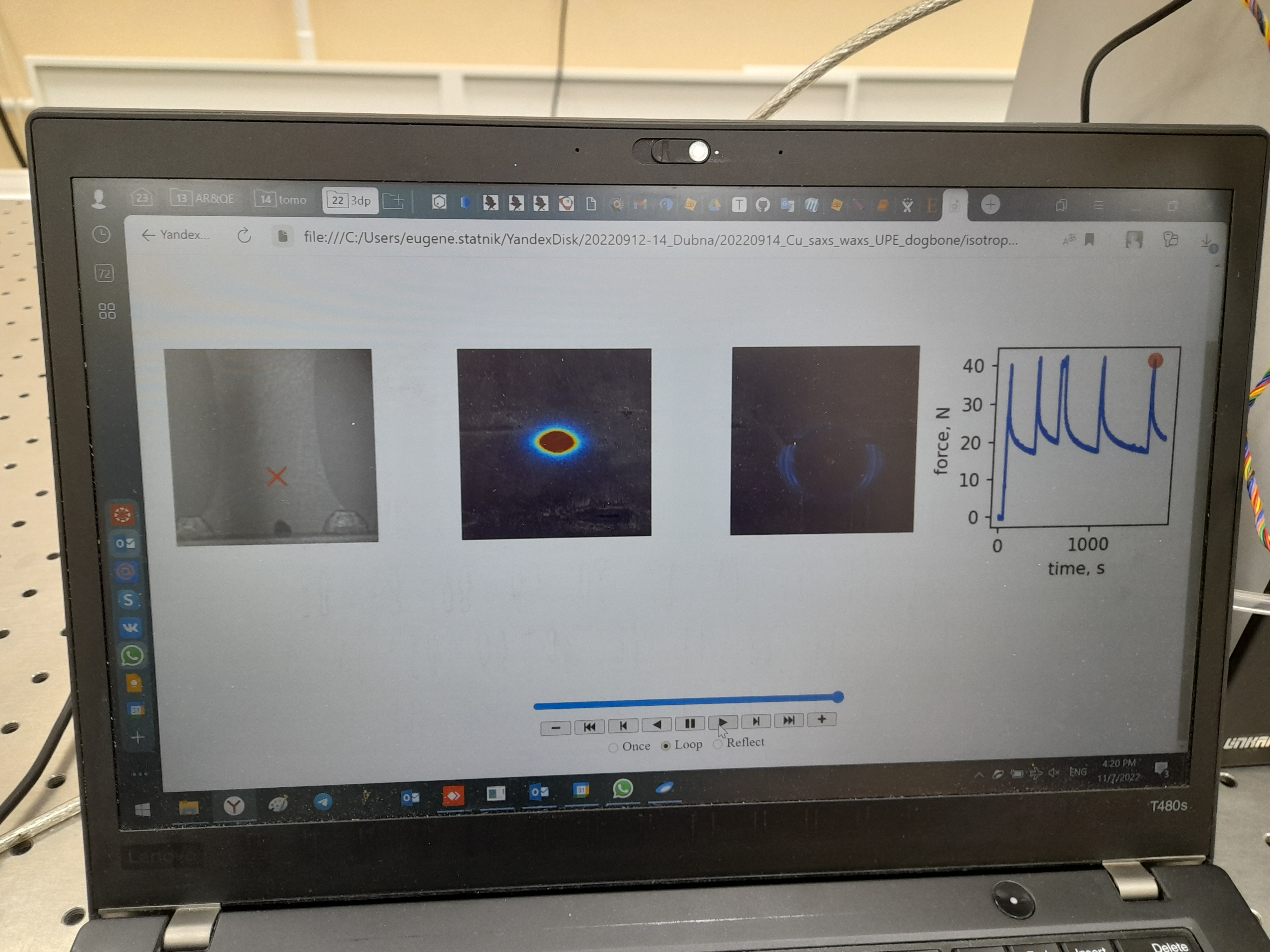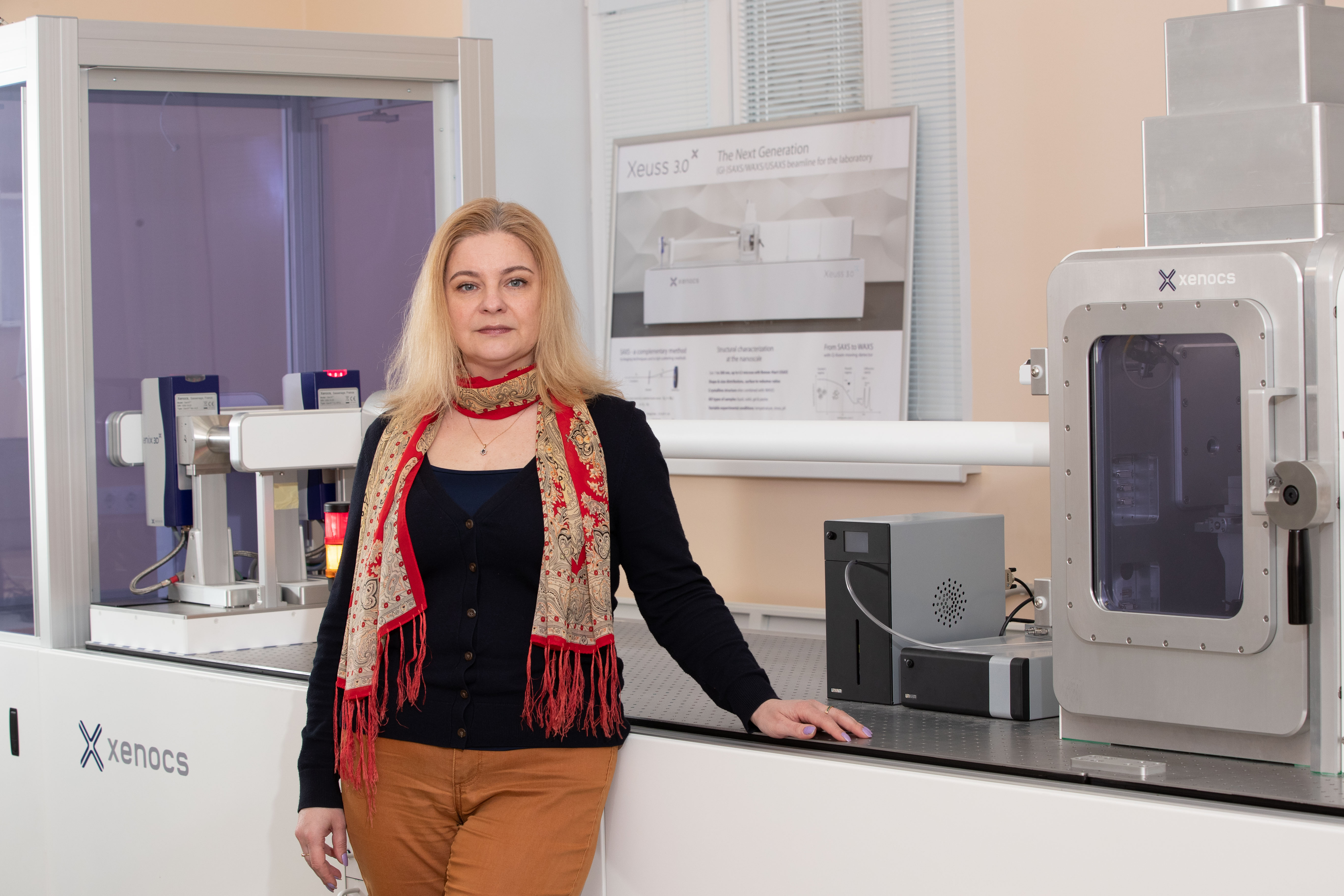Structural studies of future materials conducted at JINR
News, 20 March 2023
National University of Science and Technology MISiS researchers together with scientists from the Laboratory of Neutron Physics JINR conducted studies of biocompatible polymer materials used in endoprostheses, as well as advanced carbon composites at the Xeuss 3.0 X-ray scattering station. Carbon fibre composite material is known for its use in aviation, as well as in the creation of exoprostheses, i. e. prostheses. Within the framework of these studies, JINR is part of the collaboration of the Laboratory of Accelerated Particles (“Luch”), which is being created at NUST MISiS.
NUST MISiS specialists use Xeuss 3.0 to analyse the crystal and molecular structure of new materials being developed. According to the Head of the Department of Physical Chemistry of NUST MISiS, Deputy Head of the “Luch” Laboratory, Candidate of Physics and Mathematics Alexey Salimon, it is the small angle X-ray scattering that is best suited for the study of polymer materials.
 From left to right: participants of the materials research at Xeuss Alexey Salimon and Evgeny Statnik (Skoltech)
From left to right: participants of the materials research at Xeuss Alexey Salimon and Evgeny Statnik (Skoltech)
In order to provide the necessary set of properties of the created material, it is important to form its structure correctly. The next stage is the testing, in particular, in the case of implantology, special biological tests. “It is always a labor-intensive process of moving in the circle “structural studies – properties testing — application”. Researchers have to circulate in it for a long time in order to refine the task and improve the characteristics of the material,” the scientist said.
“Xeuss is a unique tool used specifically for structural research,” he noted. Alexey Salimon explained that his scientific group was motivated to work on Xeuss by such an advantage as a small illumination spot, i. e. the region of interest under study in the material volume. “This instrument has a very sharp focus with an illumination spot size on the sample of no more than 100-150 microns. You will not get such a resolution capability on most laboratory X—ray sources,” the scientist added. Sharp focus is important because it allows studying the peculiarities of strain distribution, in particular, when loading complex porous structures of carbon composite materials.
It is known that synchrotrons provide the strongest X-ray focus, but these are high-class and expensive instruments, and there are few of them in the world. “Modern laboratory instruments of the Xeuss class approach synchrotrons in a number of properties in the complex. This is a good possibility to fill the gap between extremely expensive megasience class instruments and traditional laboratory ones,” Alexey Salimon said.
 Frame testing device in the Xeuss 3.0 working chamber
Frame testing device in the Xeuss 3.0 working chamber
 X-ray scattering facility Xeuss 3.0
X-ray scattering facility Xeuss 3.0
A special frame testing device was created to simulate the mechanical loads of carbon composite samples. A small beam cut out of carbon composite is fixed in the device between two stops and, having installed Xeuss in the working chamber, loaded by pushing the stops against each other. As a result, it is possible to track in real time how the rupture occurs, what pressure must be applied, and how it correlates with the internal structure.
Fracture of the carbon composite beam in the testing device in the Xeuss 3.0 chamber (video)
The innovative material for endoprostheses based on ultra-high-molecular-weight polyethylene (UHMWPE) combines three layers: solid, imitating smooth cartilage, porous UHMWPE, imitating sponge-like bone tissue, and porous collagen. It is very difficult to reproduce exactly the complex tissues of the human body. That is why composite and hybrid materials in bioengineering are the most common solution.
“Our materials for hip and knee joints are at the stage of preclinical development. A unique property of polymers is used in the endoprothesis of a hip joint, a low friction coefficient and high abrasion resistance,” Alexey Salimon highlighted. He told that the developed material makes it possible to carry out work both on the creation of artificial joints and on the reconstruction of the bones themselves. In the case of cancer, in order to save a limb, it is possible to replace large fragments of the thigh bone or shinbone of the leg, ulna, humerus bones of the arm, and other large bones. The “Bioengineering” Research and Education Centre at MISiS showed this in veterinary medicine, in operations on pets. It is much easier to obtain permission to use the material in surgeries on animals, just a signature from the owner, consent to use the innovative solution is enough.
Ultra-high-molecular-weight polyethylene has been used in surgery for a long time. “We are expanding and improving the standard types of such polymers and giving them special properties. In particular, for the hip joint cup, NUST MISiS was able to significantly reduce the friction coefficient and increase abrasion resistance through the use of carbon nanotubes,” the scientist said.
 Analysis of structural studies of carbon composites
Analysis of structural studies of carbon composites
In addition to small-angle X-ray scattering by Xeuss, MISiS scientists use other methods of structural analysis: pores, discontinuities, and defects are tracked using tomography at the Academician O. V. Roman Powder Metallurgy Institute, the chemical states of the atoms in the sample are refined with high precision using the EXAFS Extended X-ray Absorption Fine Structure method.
Biocompatibility and other interesting properties of materials of the future are actively used in maxillofacial surgery. MISiS partners from the Research Institute of Emergency Pediatric Surgery and Traumatology use such materials in the tasks of reconstructing the cranial vault after craniocerebral trauma surgeries. “In the modern era, if brain edema begins after a traumatic brain injury, surgeons need to remove from a third to half of the area of the patient’s skull, which then has to be covered. And one of the solutions here is the use of a complex titanium-polymer structure, where the polymer is the one that we are developing,” Alexey Salimon said.
The work done was commented on by an FLNP senior researcher, Candidate of Physics and Mathematics Julia Gorshkova: “In 2022, the MISiS team and I conducted “targeting” experiments on the topic of biocompatible polymer materials and advanced carbon composites on Xeuss 3.0. In fact, these were commissioning works on the facility. At this stage it was important for us to determine the limits of the device ourselves. The results obtained were impressive, and we included them in a joint publication1.” Julia Gorshkova said that on 15 February, Xeuss 3.0 facility was officially put into operation. “Today we already have plans to further develop mutually beneficial cooperation with the team of Professor Alexander Korsunsky on a regular basis. This is exactly the case when we have something to offer, and we have something to learn from our colleagues,” she said.
 FLNP senior researcher, Candidate of Physics and Mathematics Julia Gorshkova
FLNP senior researcher, Candidate of Physics and Mathematics Julia Gorshkova
For reference
Xeuss 3.0 implements the method of small-angle (SAXS) and wide-angle (WAXS) X-ray scattering and makes it possible to carry them out in one run, saving time for research. Liquids and amorphous bodies, polycrystalline and porous substances, alloys, powders can also be studied by WAXS. On the device, it is possible to study the structure of materials and nanomaterials from atomic to nanoscale in real time.
Other participants of the “Luch” collaboration include Skoltech, the Academician O. V. Roman Powder Metallurgy Institute (Belarus), Department of Electromagnetic Processes and Atomic Nuclei Interactions of the MSU Skobeltsyn Institute of Nuclear Physics, the Technological Institute of Superhard and Novel Carbon Materials (TISNCM), and the Laboratory of X-ray Optics of the A. N. Lebedev Physical Institute.
Literature
- Eugene S. Statnik, Alexey I. Salimon, Yulia E. Gorshkova, Natallia S. Kaladzinskaya, Ludmila V. Markova and Alexander M. Korsunsky. Stress relaxation analysis in bulk and porous Ultra-High Molecular Weight Polyethylene (UHMWPE). Polymers 2022, 14, 5374. IF 4.967, Q1 (SRJ 0.73) https://doi.org/10.3390/polym14245374